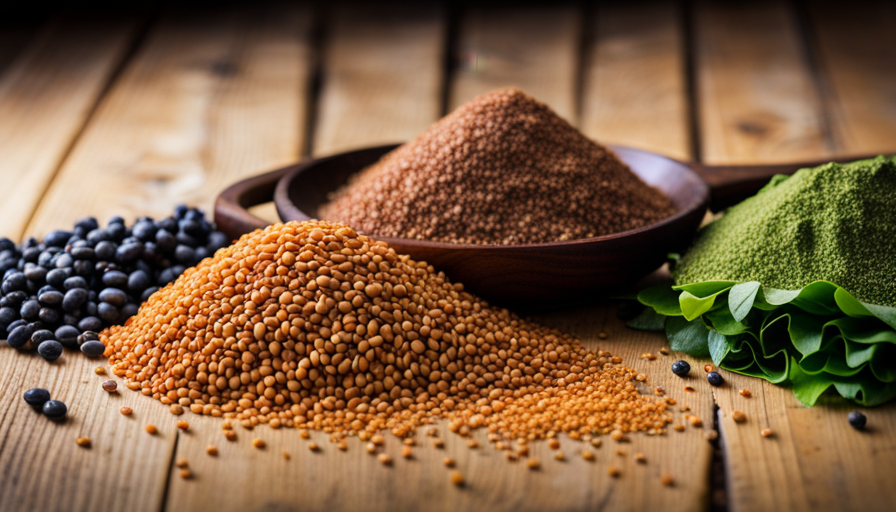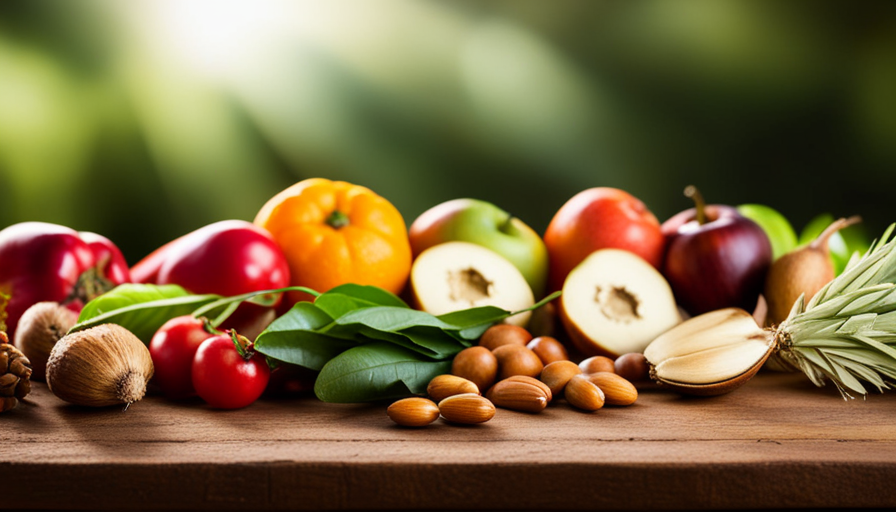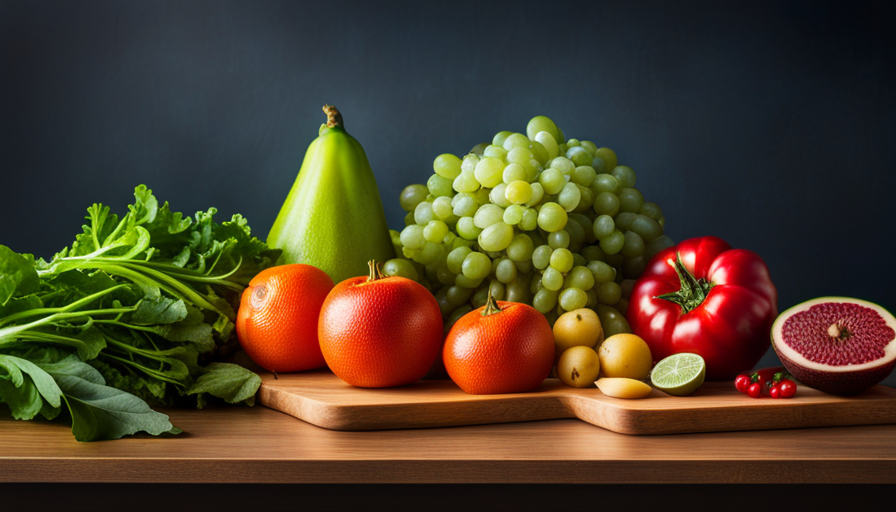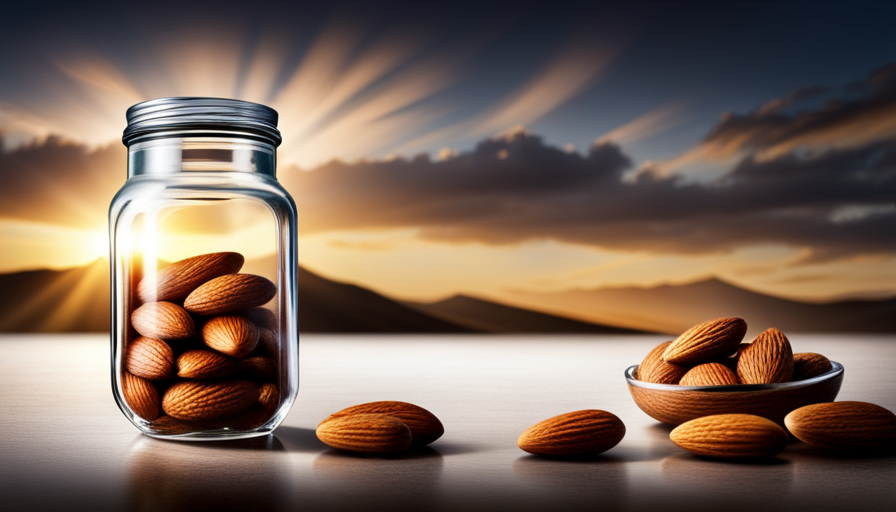Picture yourself in a lush, thriving garden, surrounded by an assortment of ripe, unprocessed fruits and vegetables. The sun shines down, filling the air with the pleasant aroma of nature’s bounty. Welcome to the world of the raw food lifestyle, promoting the consumption of unrefined, nutrient-rich foods in their natural state.
While the benefits of such a diet are plentiful, one question often arises: how can we ensure we are getting enough protein? In this article, I will guide you through the art of obtaining adequate protein on a raw food diet.
We will explore the importance of protein, discover protein-rich foods, learn about optimal food combinations for absorption, and even delve into the world of raw protein recipes.
So grab your apron and let’s embark on a journey to nourish our bodies with the raw power of protein!
Key Takeaways
- Sprouted legumes and seeds, leafy greens, hemp seeds, chia seeds, nuts and seeds, and legumes are excellent sources of protein on a raw food diet.
- Combining different plant-based protein sources maximizes protein absorption and provides variety.
- Plant-based protein powders derived from sources like peas, hemp, and brown rice are suitable for a raw food diet and offer a convenient way to meet protein needs.
- Monitoring protein intake, adjusting as necessary, and seeking guidance from a nutritionist or dietitian can help ensure the right balance of nutrients on a raw food diet.
Understand the Importance of Protein in a Raw Food Diet
Protein is absolutely crucial in a raw food diet because it’s the secret ingredient that keeps your body energized and your taste buds dancing! When following a raw food diet, it’s important to understand where to get your protein from and how much you need to meet your body’s requirements.
There are plenty of protein sources available on a raw food diet. One of the best sources is sprouted legumes and seeds, such as lentils, chickpeas, and sunflower seeds. These foods aren’t just rich in protein but also packed with essential nutrients that support overall health.
Leafy greens like spinach and kale also provide a good amount of protein, along with other vitamins and minerals.
To ensure you’re meeting your protein requirements, it’s essential to incorporate protein-rich foods into your meals. For example, you can add hemp seeds or chia seeds to your morning smoothie or sprinkle them on top of your salads. Another option is to make a delicious raw nut and seed-based protein bar or snack. These additions won’t just boost your protein intake but also add a satisfying crunch and flavor to your meals.
By understanding the importance of protein in a raw food diet and incorporating protein-rich foods into your meals, you can ensure you’re meeting your body’s nutritional needs while enjoying a delicious and energizing diet.
Now, let’s explore how to create protein-packed raw meals that’ll leave you feeling satisfied and nourished.
Incorporate Protein-Rich Foods into Your Meals
When it comes to incorporating protein-rich foods into my meals on a raw food diet, I make sure to include nuts and seeds in my daily intake. These little powerhouses are not only packed with protein but also provide essential fats and minerals.
Additionally, I love adding legumes and beans to my recipes as they’re not only a great source of protein but also high in fiber and other nutrients.
Lastly, I often include spirulina and chlorella in my smoothies as these algae are loaded with protein and can easily be blended into a delicious and nutritious drink.
Include Nuts and Seeds in Your Diet
Including nuts and seeds in your diet can be a piece of cake, as they’re a great source of protein on a raw food diet. Nuts and seeds aren’t just delicious, but they also offer numerous health benefits. Here are three reasons why you should include them in your raw food meals:
-
Protein powerhouses: Nuts and seeds are packed with protein, making them an excellent choice for meeting your daily protein needs. They provide essential amino acids that’re important for muscle repair and growth.
-
Nutrient-dense: Nuts and seeds are rich in vitamins, minerals, and antioxidants. They offer a wide range of nutrients, including healthy fats, fiber, and plant compounds that promote overall health and wellbeing.
-
Versatile and satisfying: Nuts and seeds can be easily incorporated into your raw food recipes. They can be sprinkled on salads, blended into smoothies, or used as a base for raw desserts. They add a satisfying crunch and enhance the flavor of your dishes.
By including nuts and seeds in your diet, you can ensure you’re getting enough protein while enjoying the many benefits they offer.
Next, we’ll explore how to add legumes and beans to your recipes.
Add Legumes and Beans to Your Recipes
Incorporating legumes and beans into your meals is like adding flavorful and nutritious building blocks to your culinary creations. These protein alternatives are not only delicious but also packed with essential nutrients. Legumes and beans offer a wide range of nutritional benefits, including high protein content, fiber, vitamins, and minerals. They are also low in fat and cholesterol, making them a healthy addition to any raw food diet. To help you understand their nutritional value, here is a table showcasing the protein content of some common legumes and beans:
| Legumes/Beans | Protein Content (per 100g) |
|---|---|
| Lentils | 9g |
| Chickpeas | 19g |
| Black beans | 21g |
Adding legumes and beans to your recipes not only increases the protein content but also enhances the taste and texture. Now, let’s explore another protein-rich ingredient: spirulina and chlorella in your smoothies.
Include Spirulina and Chlorella in Your Smoothies
To boost the nutritional value and add a vibrant green color to your smoothies, try including spirulina and chlorella. These superfoods will take your taste buds on a healthy and refreshing journey. They are packed with essential nutrients and can be a great addition to your raw food diet.
Here are some benefits of spirulina:
- High in protein: Spirulina is a complete protein source, containing all the essential amino acids our bodies need.
- Rich in antioxidants: It’s loaded with antioxidants that help fight oxidative stress and reduce inflammation in the body.
- Boosts energy levels: Spirulina improves endurance and increases energy levels, making it perfect for pre-workout smoothies.
And here are some ideas for incorporating chlorella into your smoothies:
- Chlorella and fruit smoothie: Blend chlorella powder with your favorite fruits for a refreshing and nutrient-packed smoothie.
- Green detox smoothie: Combine chlorella, spinach, cucumber, and lemon juice for a detoxifying and cleansing drink.
- Chlorella and coconut smoothie: Mix chlorella powder with coconut water and a splash of lime juice for a tropical twist.
By including spirulina and chlorella in your smoothies, you can easily increase your protein intake and enjoy the numerous health benefits they offer.
Now, let’s move on to optimizing food combinations for better protein absorption.
Optimize Food Combinations for Protein Absorption
In order to maximize protein absorption on a raw food diet, it’s crucial to carefully pair plant-based protein sources that complement each other’s amino acid profiles. By combining certain foods, you can ensure that you are getting all the essential amino acids your body needs for optimal protein synthesis.
Here is a table that shows some examples of food combinations that can enhance protein absorption:
| Food Combination | Protein Source 1 | Protein Source 2 |
|---|---|---|
| Beans and Rice | Beans | Rice |
| Quinoa and Chickpeas | Quinoa | Chickpeas |
| Lentils and Spinach | Lentils | Spinach |
| Almonds and Broccoli | Almonds | Broccoli |
These combinations are effective because they provide a wider range of amino acids compared to consuming a single protein source. By diversifying your protein sources, you increase the chances of meeting your body’s requirements for all essential amino acids.
In addition to optimizing food combinations, it’s also important to consider protein supplements to ensure you are meeting your protein needs on a raw food diet. This will be discussed further in the next section.
Consider Protein Supplements
When it comes to getting enough protein on a raw food diet, one option to consider is plant-based protein powders. These powders are a convenient and easy way to supplement your protein intake, and there are many different options available to suit different dietary preferences.
Another option to consider is incorporating hemp seeds or chia seeds into your diet, as these seeds are high in protein and can be easily added to smoothies, salads, or other dishes.
Choose Plant-Based Protein Powders
If you’re looking to boost your protein intake on a raw food diet, plant-based protein powders can be a game-changer. They offer a convenient and effective way to meet your protein needs without compromising your raw food principles.
Plant-based protein powders are derived from sources like peas, hemp, and brown rice, making them suitable for a raw food diet. These powders are rich in essential amino acids, which are the building blocks of protein. They also provide a wide range of vitamins and minerals that support overall health. Additionally, plant-based protein powders are easily digestible, ensuring optimal nutrient absorption.
Incorporating these powders into your raw food meals and snacks can help you reach your protein requirements and maintain a balanced diet. So, if you’re looking for an easy and nutritious way to boost your protein intake, give plant-based protein powders a try. After all, variety is key when it comes to meeting your nutritional needs.
Next, let’s explore another protein-boosting option: hemp seeds or chia seeds.
Try Hemp Seeds or Chia Seeds as Protein Boosters
After discussing the benefits of plant-based protein powders in the previous section, let’s now shift our focus to two specific protein-rich foods: hemp seeds and chia seeds.
These tiny powerhouses are excellent sources of protein and can easily be incorporated into a raw food diet. Hemp seeds are not only packed with protein, but they also contain essential fatty acids and minerals like magnesium and iron. They can be sprinkled over salads, blended into smoothies, or added to homemade protein bars.
On the other hand, chia seeds are not only rich in protein but also provide a good amount of fiber and omega-3 fatty acids. They can be used in a variety of recipes, such as chia seed puddings, energy balls, or added to smoothies for an extra protein boost.
Now that we’ve explored these protein-packed seeds, let’s move on to the next section and discover how we can experiment with raw protein recipes.
Experiment with Raw Protein Recipes
To amp up your protein intake on a raw food diet, dive into an array of mouthwatering raw protein recipes that’ll make your taste buds dance with delight. Experimenting with protein sources isn’t just a fun culinary adventure, but it also offers numerous benefits. Here are four reasons why you should give raw protein recipes a try:
-
Variety: Raw protein recipes let you explore a wide range of plant-based protein sources like nuts, seeds, and legumes. From raw vegan burgers to zucchini noodles with creamy almond sauce, the options are endless.
-
Nutrient-dense: Raw protein recipes retain the maximum nutritional value of the ingredients. By consuming these uncooked and minimally processed foods, you can make sure you’re getting all the essential amino acids, vitamins, and minerals your body needs.
-
Digestive health: Raw protein recipes often include foods high in fiber, which support a healthy digestive system. Incorporating these recipes into your diet can help improve digestion and prevent constipation.
-
Energy boost: Raw protein recipes are packed with natural enzymes, antioxidants, and phytonutrients that provide a natural energy boost. You’ll feel revitalized and ready to take on the day!
Now that you know the benefits of raw protein recipes, let’s move on to the next step: paying attention to portion sizes.
Pay Attention to Portion Sizes
Make sure you keep an eye on how much you’re serving yourself when enjoying these delicious raw protein recipes – portion sizes matter! Portion control is an important aspect of maintaining a balanced raw food diet while ensuring you get enough protein. It’s easy to get carried away with the flavors and textures of these recipes, but remember that moderation is key.
To help you visualize appropriate portion sizes for protein sources on a raw food diet, here’s a handy table:
| Protein Source | Portion Size |
|---|---|
| Nuts and Seeds | 1 ounce |
| Legumes | 1/2 cup |
| Leafy Greens | 2 cups |
| Sprouts | 1 cup |
| Fermented Foods | 1/4 cup |
By following these portion sizes, you can ensure you’re getting enough protein without overdoing it. It’s also important to note that variety is essential in a raw food diet, so be sure to include a mix of protein sources in your meals.
Now that you know about portion control, let’s move on to the next step: staying hydrated for optimal protein digestion.
Stay Hydrated for Optimal Protein Digestion
Stay hydrated to ensure that your body can efficiently break down and digest the protein you consume. Keeping your protein intake on track is like lubricating the gears of a well-oiled machine.
Hydration benefits are numerous when it comes to protein digestion. Here are some tips to help you stay hydrated and optimize protein digestion:
-
Drink plenty of water: Water is essential for proper digestion and absorption of nutrients, including protein. Aim to drink at least 8 glasses of water per day.
-
Include hydrating foods: Foods like cucumbers, watermelon, and celery are high in water content and can contribute to your hydration levels.
-
Avoid excessive caffeine and alcohol: Both caffeine and alcohol can dehydrate your body, making it harder for protein digestion to occur efficiently.
Proper hydration helps your body break down protein more effectively, ensuring that you get the most out of your raw food diet. It aids in the digestion process and supports the absorption of amino acids, which are the building blocks of protein. So, make sure to stay hydrated to optimize protein digestion and meet your body’s protein needs.
Now, let’s transition into the next section about listening to your body’s protein needs without writing ‘step’.
Listen to Your Body’s Protein Needs
Discover how your body intuitively communicates its protein needs, guiding you towards a nourishing and balanced diet. Our bodies have a remarkable ability to indicate when we need more protein. Paying attention to these signals can help ensure that we meet our body’s protein requirements while following a raw food diet.
One way to monitor protein intake is by listening to our appetite. When we’re lacking protein, our bodies often crave foods that are rich in this essential nutrient. These cravings can manifest as a desire for foods like legumes, nuts, seeds, or even certain fruits and vegetables that contain higher protein content. By tuning in and honoring these cravings, we can ensure that we’re meeting our body’s protein needs.
Another indicator of our protein requirements is our energy levels. If we find ourselves feeling fatigued or lacking stamina, it could be a sign that we need to increase our protein intake. Protein plays a crucial role in muscle repair and energy production, so it’s important to listen to our bodies and provide the necessary fuel.
Understanding our body’s protein requirements and monitoring our protein intake is key to maintaining a healthy raw food diet. By paying attention to our appetite and energy levels, we can ensure that we’re meeting our body’s needs. However, it’s always a good idea to seek guidance from a nutritionist or dietitian to ensure we’re getting the right balance of nutrients.
Seek Guidance from a Nutritionist or Dietitian
Consider consulting with a nutritionist or dietitian to ensure that you receive expert guidance on meeting your body’s unique protein requirements while following a raw food lifestyle. These professionals can provide invaluable support and knowledge to help you optimize your protein intake and overall nutritional status.
Here are some benefits of working with a nutritionist or dietitian:
-
Personalized advice: A nutritionist or dietitian can assess your specific needs and create a customized plan to meet your protein requirements. They’ll take into account factors like your age, gender, activity level, and any underlying health conditions.
-
Expert knowledge: These professionals have extensive training in nutrition and can provide evidence-based recommendations to ensure you’re getting enough protein from plant-based sources. They can also guide you on how to combine different foods to enhance protein absorption.
-
Support and accountability: Having a nutritionist or dietitian by your side can provide the motivation and support you need to stick to your raw food diet and meet your protein goals. They can answer your questions, address any concerns, and help you navigate any challenges you may encounter.
By seeking guidance from a nutritionist or dietitian, you can confidently embark on your raw food journey and ensure that you’re meeting your protein needs.
In the next section, we’ll discuss how to monitor your protein intake and adjust as needed.
Monitor Your Protein Intake and Adjust as Needed
Keep an eye on how much protein you’re consuming and make adjustments as necessary, just like a skilled chef fine-tuning a recipe to achieve the perfect balance of flavors.
When following a raw food diet, it’s crucial to monitor your protein intake to ensure you’re getting enough of this essential nutrient. While raw plant foods can provide a good amount of protein, it’s important to track your protein consumption and adjust your levels accordingly.
To monitor your protein intake, you can use various tools and resources available. Keeping a food diary or using a nutrition tracking app can help you keep track of the protein content in the raw foods you consume. This information will allow you to evaluate if you’re meeting your protein needs or if adjustments are necessary.
If you find that you’re not getting enough protein on a raw food diet, there are several steps you can take to adjust your intake. Firstly, you can incorporate more protein-rich raw plant foods into your diet, such as nuts, seeds, legumes, and leafy greens. These foods are not only high in protein but also offer other beneficial nutrients. Secondly, you can consider including raw plant-based protein powders or supplements to ensure you’re meeting your protein requirements.
Remember, everyone’s protein needs may vary based on factors like age, gender, activity level, and overall health. By monitoring your protein intake and making adjustments as needed, you can ensure that you’re getting enough protein to support your body’s functions and maintain optimal health on a raw food diet.
Frequently Asked Questions
Can I get enough protein on a raw food diet without consuming animal products?
Yes, it’s possible to get enough protein on a raw food diet without consuming animal products. There are several plant-based sources of complete proteins that can be included in a raw food diet. These include quinoa, hemp seeds, chia seeds, and spirulina. By incorporating a variety of these protein-rich plant foods into your diet and balancing your protein intake, you can ensure that you’re meeting your protein needs on a raw food diet.
How can I ensure I am getting all essential amino acids on a raw food diet?
To ensure I’m getting all essential amino acids on a raw food diet, I focus on incorporating a variety of plant-based protein sources. By including foods like quinoa, hemp seeds, chia seeds, and spirulina, I can ensure a balanced amino acid profile. These foods not only provide protein but also offer a wide range of vitamins and minerals.
Additionally, I make sure to eat a diverse selection of fruits and vegetables to boost my overall protein intake on a raw food diet.
Are there any specific fruits or vegetables that are particularly high in protein?
There are several high-protein vegetables that can be incorporated into a raw food diet. Some examples include broccoli, spinach, kale, and Brussels sprouts. These vegetables not only provide essential amino acids, but they also contain other important nutrients like vitamins and minerals.
In terms of fruits, some options with higher protein content include guava, blackberries, and kiwi. Incorporating these fruits and vegetables into your raw food diet can help ensure you’re getting enough protein.
Can I meet my protein needs solely through plant-based sources on a raw food diet?
Yes, it’s possible to meet my protein needs solely through plant-based sources on a raw food diet. There are many protein sources for raw food dieters, such as nuts, seeds, legumes, and leafy greens. These plant-based foods provide essential amino acids, which are the building blocks of protein. By including a variety of these foods in my diet, I can ensure that I’m meeting my protein needs while following a raw food lifestyle.
Are there any potential risks or side effects of consuming too much protein on a raw food diet?
There can be potential health risks associated with consuming too much protein on a raw food diet. It’s important to note that the recommended protein intake varies depending on factors such as age, sex, and activity level. Excessive protein intake can strain the kidneys and increase the risk of dehydration. It can also lead to nutrient imbalances. Consulting with a healthcare professional or registered dietitian can help ensure that you’re meeting your protein needs without exceeding them.
What Are the Best Sources of Protein for a Raw Food Diet?
When following a raw food diet, it’s essential to find adequate protein on raw diet to meet your nutritional needs. Some of the best sources of protein for this diet include nuts, seeds, legumes, and leafy greens. These options can help ensure you maintain a balanced and healthy diet while eating raw.
Conclusion
In conclusion, getting enough protein on a raw food diet is essential for maintaining optimal health and well-being. By incorporating protein-rich foods into your meals and optimizing food combinations, you can ensure that your body receives the necessary nutrients it needs. Additionally, considering protein supplements and experimenting with raw protein recipes can further support protein digestion. It’s important to listen to your body’s protein needs and seek guidance from a nutritionist or dietitian to ensure you’re on the right track. Remember to monitor your protein intake and make adjustments as needed.
Together, we can nourish our bodies and thrive on a raw food diet.









